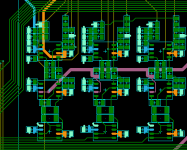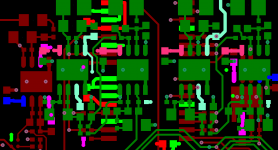Any competent cable will have series impedance sufficiently low that doubling it will make virtually no difference, and shunt impedance sufficiently high that halving it will make virtually no difference. Given this condition, there is nothing to explain. If this condition does not hold, then by definition the cable is faulty - however much you paid for it.
...
DF, a question, if I may. Say you have an older model of an amp, which has a low damping factor to begin with. Add a cable with an unusually (but not outrageously so) high impedance - don't you think there might be instances where the cable's propeties WILL become a significant factor in the sound produced, as when using such an amp with 4 Ohm loudpeakers?
Obviously, I refer to speaker cables and cases when their owner has not taken proper matching care.
Both of you forgot that there I had a question
There is always a pre-requisite for someone to be able to solve advanced problems.
I do layouts that are immune up to 18GHz for RFI, conducted susceptibility etc.... The answers are in the books by the Gentlemen mentioned and in many more forms on the internet (EMC club for instance).... There are many ways of protecting your circuitry, but these often fly against audiophile beliefs, such as using ferrites, so no specifics from me on this, I'll just do it for the mundane electronics in the world, not esoteric audio.....
http://www.trackwise.co.uk/uploads/docs/Effect_of_Trace_Dimensions_PIM.pdf
I wont go further than to say with proper design and engineering practice this wont be a problem, with esoteric audiophile design practices it may be......
Thanks Bcarso for putting up an informative talk on PIM. We follow as many rules stated there as we can with our best audio designs as well.
How much of a problem is this at audio frequencies.... microwave and telecoms yes, some figures and data please.
All wrong. In fact, it was a passion since the beginning (in the early 70). And my artwork was appreciated enough to be in charge of it. (see the image)
At this time, we had no computers to help us.
Now, when i see the artwork of people like AlexMM, who am-i to think i could do better ? (http://www.esperado.fr/images/stories/protection/PCB_ESP_REV_1-9.jpg)
Nice layout, brought back memories, don't use PTH much these days, like 25 years (except for space based stuff), nearly all SMD these days....
Similar analogue in SOIC (1.27mm Pitch) and with even smaller components (0.5mm pitch IC)... Basically your standard analogue op-amp circuits🙂
Attachments
Did-you pretend YOU cannot hear the sonic differences between caps ? That could explain a lot of things.
Many of us here are quite old people and our hearing capability has without doubt declined from what it was once upon a time - a function of ageing. For those who have had high exposure to loud sound over a long period it is probable that their hearing has been further damaged.
With this in mind I am very surprised that scientists, EEs and self-elected experts here can become so adamant and hot under the collar. Do they forget that that which they experience is not necessarily anything like that which others experience?
Yes, I used to hear even better, when I was younger. I now use what I have learned to be what has worked in the past, and by consensus of listeners, including audio critics, today, as well as my own ears. Sometimes, my measurements, and general experience tell me that a particular design that I did is not really very good, yet the listening feedback that I get from others tells me that I still am ahead of the majority of mid-fi manufacturers in this audio design business, thankfully.
What speed are we talking about here, Fermi (think that's the correct term)velocity or drift velocity?
Some papers on this would be interesting..... because I believe at 0.1mm per second the electrons are going to take a long time to get around any loop🙂
Precisely. This is why you need to keep the signal path short (as well as using silver wire or copper wire of course). If the signal path is too long, you never get the feedback 'airyness' - effectively the amp is running open loop. So the basic rules for a big open sound stage with airyness are
1. Keep the layout compact
2. Use silver or copper wire
More l8r😉
I think an amplifier has enough work to do with its own limitations to not have to care of too complex charges with an impedance varying from 4 to >25 ohms depending of the frequency !Of course it could just be covering up limitations in the power amplifier as well.
Anyway, I consider an enclosure witch has a non flat impedance curve as ... faulty. And i cannot understand why enclosures manufacturers take no care of this aspect.
Last edited:
Of course. In an other way, i believe that what we lose in accuracy, we gain in experience and way to listen (analysis capabilities).Many of us here are quite old people and our hearing capability has without doubt declined from what it was once upon a time - a function of ageing. For those who have had high exposure to loud sound over a long period it is probable that their hearing has been further damaged.
I can tell that, when i was a young sound engineer, with very high treble accuracy at the time, (>20 000Hz) i had a lot of trouble to create great cymbals sounds. Admiring the work of older engineers. During my last works, my clients made-me compliments about the cymbals. To try to explain, young, i was fighting with the brightness. Now, i'm am working with the impact, the size and the metal.
Too, when i was young, i had difficulties with complex musical scenes with too much instruments. Not any more.
In fact, what i have lost keep what i listen too more simple.
what we lose in accuracy, we gain in experience and way to listen
It's easier if one only has to listen to half the info.
Not what I would phrase as experience.
It's easier if one only has to listen to half the info.
Not what I would phrase as experience.
You must be joking, because I think Esperado is right on the mark.
I very much enjoyed the long process of getting my hearing shot (loud music, home made explosions, living life), but the harsh fact is there: the upper octave is largely absent by now.
Yet, experience makes up for that. I visted Jan Didden a couple of days ago, who was doctoring for a friend two KEF speakers that were sounding too bright. It took me about 1 second to identify which tweeter was the wrongdoer. Measurements showed it to have about -30 dB distortion. As we had hypothesized already, the culprit was dried out ferro-fluid. This problem also creates rub and buzz distortion, which is not really picked by HD measurements, so there must have been more than -30dB of unwarranted noise, not just HD, but the point is this. Mmmmuch of the noise and HD produced by the defective tweeter will have been above 10KHz, were my hearing becomes progressively impaired. In spite of this, the analysis was readily made. That is what 4 decades of obsession with loudspeakers will do to you: it will give you the experience that is required to draw adequate conclusions from sensory inputs, even if the sensors are no longer what they used to be.
Many of us here are quite old people and our hearing capability has without doubt declined from what it was once upon a time - a function of ageing. For those who have had high exposure to loud sound over a long period it is probable that their hearing has been further damaged.
With this in mind I am very surprised that scientists, EEs and self-elected experts here can become so adamant and hot under the collar. Do they forget that that which they experience is not necessarily anything like that which others experience?
Brianco, I am not arguing here, just pointing to an observation that has
been made many times by orchestral conductors. They have been exposed
to loud music all their lives and also suffer the loss of hearing too.
Strangely this hearing decline has not hindered their ability to hear the
music and point to instruments, musicians, choir that are performing
slightly out of tune, off key, or not correctly.
We can perceive far more than testing give us credit for.
Think "face recognition" of your son in a crowd ;-)It's easier if one only has to listen to half the info.
Not what I would phrase as experience.
Who is the idiot who invented this horror ? They all dry-out very fast and a glued moving coil produces awful sounds.the culprit was dried out ferro-fluid.
Last edited:
Who is the idiot who invented this horror ? They all dry-out very fast and a glued moving coil is not ideal.
I was surprised when I looked up the formulations. They could be made much, much better than they are.
I lived with a g/f for half a decade who had an aunt, blind as a mole since childhood.
In her familiar surrounding, with help of her dog, she got by quite well.
Everywhere else she was a total disaster, straight out of a slapstick classic.
So much for experience.
A 25 year old EE can make up for lack of experience with excellent hearing.
In her familiar surrounding, with help of her dog, she got by quite well.
Everywhere else she was a total disaster, straight out of a slapstick classic.
So much for experience.
A 25 year old EE can make up for lack of experience with excellent hearing.
This is like the people who say we never went to the moon
I have a sneaking suspicion the Soviets might have said something had we not.
- Status
- Not open for further replies.
- Home
- Member Areas
- The Lounge
- John Curl's Blowtorch preamplifier part II


